For years I wanted to candy whole fruit and finally I candied whole mandarin oranges, kiwis, pears and cherries! It takes at least 5 days to candy whole fruit but it’s totally worth it!
In the past, I candied watermelon rind, orange slices, cherries and lemon and orange peel. However, I couldn’t find a modern recipe for whole candied fruit. But I finally found historical recipes for whole candied fruit. Yay!
Whole candied fruit – also called crystallized fruit or glaze fruit – were popular in the Victorian and Edwardian era, so I found 5 different Victorian & Edwardian recipes for whole candied fruit such as candied peaches, apricots, pears, plums, greengages, mirabelles, cherries and pineapples.
Whole candied kiwi were my favorite: They became translucent and were so delicious!
Victorian Whole Candied Fruit – 5 Recipes
The following recipe are from the Victorian and Edwardian era – scroll down for the adapted recipe!
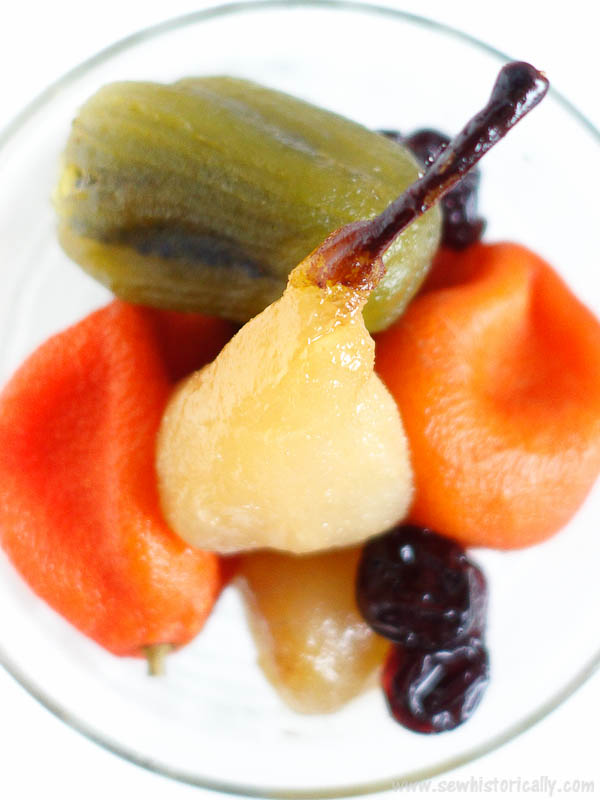
How To Make Crystallized Or Glaze Fruit
‘The principle is to extract the juice from the fruit and replace it with sugar syrup, which hardens and preserves the fruit in its natural shape. The fruit should be all of one size and of a uniform degree of ripeness, such as is best for canning. Peaches, pears, and similar fruits are pared and cut in halves; plums, cherries, etc., are pitted.
After being properly prepared, the fruit is put in a basket or bucket with a perforated bottom and immersed in boiling water to dilute and extract the juice. This is the most important part of the process, and requires great skill. If the fruit be left too long, it is over-cooked and becomes soft; if not long enough, the juice is not sufficiently extracted, and this prevents perfect absorption of the sugar. After the fruit cools, it may again be assorted as to softness.
The syrup is made of white sugar and water. The softer the fruit, the heavier the syrup required. The fruit is placed in earthen pans, covered with syrup, and left about a week. This is a critical stage, as fermentation will soon take place; and when this has reached a certain stage, the fruit and syrup are heated to the boiling-point, which checks the fermentation. This is repeated, as often as may be necessary, for about six weeks.
The fruit is taken out of the syrup, washed in clean water, and either glaced or crystallized, as desired. It is dipped in thick syrup, and hardened quickly in the open air for glaceing, or left to be hardened slowly if to be crystallized. The fruit is now ready for packing, and will keep in any climate.’ (Farm And Garden Rule Book, 1911)
How To Make Candied And Crystallized Fruit From Preserved Fruit
‘Apricots, green almonds, greengages, mirabelles, cherries, and in fact all preserved fruits, must first be washed in hot water to remove the sugar adhering to them, then drain and leave to dry properly. After these fruits are very dry arrange them in a single layer, one beside the other, in a candy pan having a grate on the bottom; when this first grate is full lay another one on top and till it the same as the other, and continue thus until they reach to slightly below the edges of the candy pan. Cover the last layer of fruits with another grate, and on it lay a weight to keep the fruits submerged in the syrup.
Now cook a sufficient quantity of sugar to thirty four degrees to cover the whole of the fruit and pour it over as soon as done; put these fruits in a hot closet and leave without disturbing for twelve hours; at the end of that time drain the fruits from this syrup, lay them on dry grates and leave till very dry.
A good way to judge of the thickness of the layers of candy is to put small pieces of wood reaching above the edges of the candy pan into the corners at the same time as the fruits. After a few hours take out one of these pieces of wood, drain it well and see whether it be covered with a sufficiently thick layer of candy; if the layer attached to this piece of wood be the desired thickness then certainly the fruit should be covered the same, and if not thick enough then leave the fruits in the closet for a longer time. After the lapse of a short time draw out another one of the sticks and observe it the same as the first, and continue this operation until the candy be of the desired thickness; then drain off the fruits and dry them the same as described above.’ (The Epicurean, 1893)
Candied Fruit – Plums, Peaches Or Cherries
- plums, peaches or cherries
- 1 pound sugar
- 1 cup water
Related: Homemade Candied Cherries
‘Peel and stone plums, peaches, or cherries. Have ready a thick syrup, made by boiling together one pound of sugar to one cup of water. […] Put in the fruit, and boil very slowly till tender. Do not leave it on the stove after this, it would spoil the shape of the fruit. Set away the preserving-kettle, just as it is, in a cool place. Leave the fruit in the syrup for two days, to absorb it.
Take out the pieces then, and drain them. Sprinkle each one thickly with granulated sugar, covering every side. Lay them on clean paper, and set in the air (but not in the sun) to dry. Turn them often. Pack in pasteboard boxes, with paper laid between the layers. Keep in a cool place. Candied fruit is easily made, and is useful in a house subject to the sudden arrival of company, as a variety of pretty desserts can quickly be made with it.’ (How To Cook Well, 1886)
Crystallized Pears
- pears
- 2 cups sugar
- 1 cup water
‘Take specked or Bartlett pears which have not begun to ripen, and pare them, leaving the stems on. Prick in several places, cover with cold water, and add a crystal of burnt alum for each two pears. Bring to boiling point, and cook gently until they are tender, being careful that they do not go to pieces. Put pears in cold water, changing it several times until pears look clear.
Make syrup by boiling two cups sugar and one cup water five minutes, then cool. Drain pears, cover with cold syrup, and leave for twenty-four hours. Drain syrup from pears, add one cup sugar, bring to boiling point, cool, and pour over pears. Again let stand for twenty-four hours, drain syrup, add one cup sugar, bring to boiling point, and pour over the pears while hot.
Again let stand for twenty-four hours, drain off syrup, and cook until it spins a long thread. Add pears, let them boil for one minute, and return both fruit and syrup to the crock for another twenty-four hours. Drain syrup, cook to 280 F., add pears, let them boil once, remove from syrup, let fruit dry, and it is ready for use.’ (Candy Cook Book, 1912)
Candied Fruit – Peaches, Pears Or Pineapples
- peaches, pears or pineapples
- 1 pound sugar
- 1 cup water
- optional: chopped almonds or peach stones
Related: 30 Historical Recipes With Apricot Kernels, Peach Kernels & Cherry Pits
‘Choose large ripe but firm peaches for this purpose. Peel, and halve. Make a thick syrup with granulated sugar and water, using a cupful of water to each pound of sugar. Place the peaches in this and bring to a boil. Simmer for about five minutes; then remove from fire, and let stand overnight in the syrup.
Place over the fire again, and allow the peaches to simmer another five minutes. Skim carefully out on to platters, and place in the sun or in a slow oven until dry.
Again bring the syrup to a boil, add the peaches and simmer to the crystal state, then remove the peaches on to platters again, and let dry as before. Before they are quite dry, sprinkle with chopped almonds, or the kernels of the peach-stones can be chopped and used. When completely dry, pack in boxes lined with paraffin-paper, and place a sheet of paper between each two layers. Pears and pineapples may be candied in the same manner.’ (Preserving And Pickling, 1917)
How To Make Victorian Whole Candied Fruit
I candied whole mandarin oranges, pears, kiwi and cherries adapting the ‘Crystallized Pears’ recipe.
Ingredients:
- 2 mandarin oranges
- 2 pears
- 2 kiwis
- 1 handful (frozen) cherries
- 2 cups sugar
- 1 cup water
Directions:
Day 1
Peel the kiwis and pears leaving the stems of the pears intact. Prick the the mandarin oranges, kiwis and pears all over with a sharp needle.
Put the fruits in four separate saucepans, cover with cold water and bring to a boil. Reduce the heat and simmer the fruit until soft. I let the cherries simmer for 5 minutes, the kiwis and pears for 10 minutes, and the mandarin oranges for 15 minutes.
Put the fruit separately in four bowls with cold water until cold. Then drain the fruit and put them in a glass jar (or in 4 separate glass jars).
Cook 2 cups sugar and 1 cup water for five minutes. Let the syrup cool down and pour it over the fruit until they are covered. Weigh the fruit down so that they don’t float on top of the syrup. I used small glasses to weigh the fruit down.
Let the fruit stand for 24 hours at room temperature.
Day 2
Drain the syrup from the fruit, add one cup of sugar, bring to boil. Let the syrup cool down and pour it over the fruit. Let the fruit stand for 24 hours again.
Day 3
Drain the syrup from the fruit, add one cup of sugar, bring to boil and pour it over the fruit while hot. Let stand for another 24 hours.
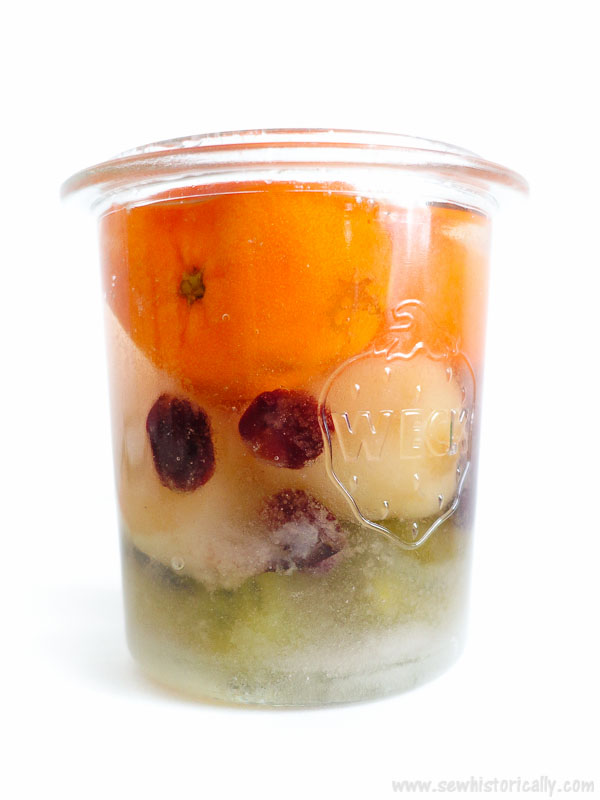
Day 4
Drain off the syrup and cook until it spins a long thread. Add fruit, let them boil for 1 minute and let stand for 24 hours again.
Day 5
Drain the syrup, cook to 280°F (130°C), add the whole candied fruit and let them boil once. Then remove the candied fruit from the syrup, let them dry. And the Victorial whole candied fruit are ready for use!
You can the syrup instead of sugar for tea, lemonade, ice cream or cake.
More Candied Fruit Recipes
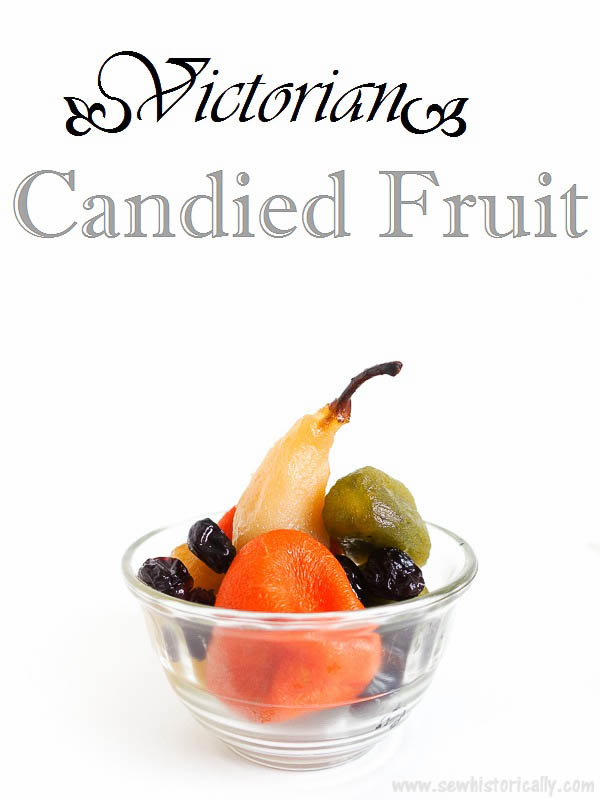
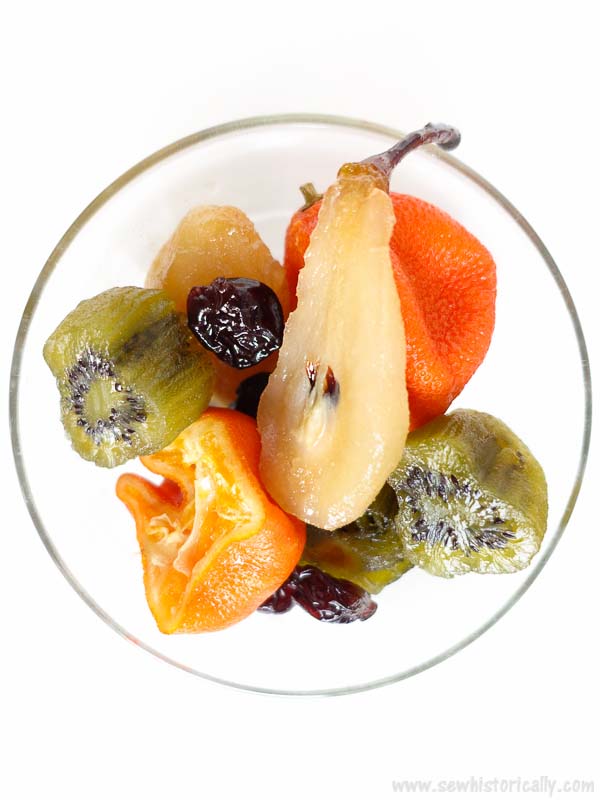
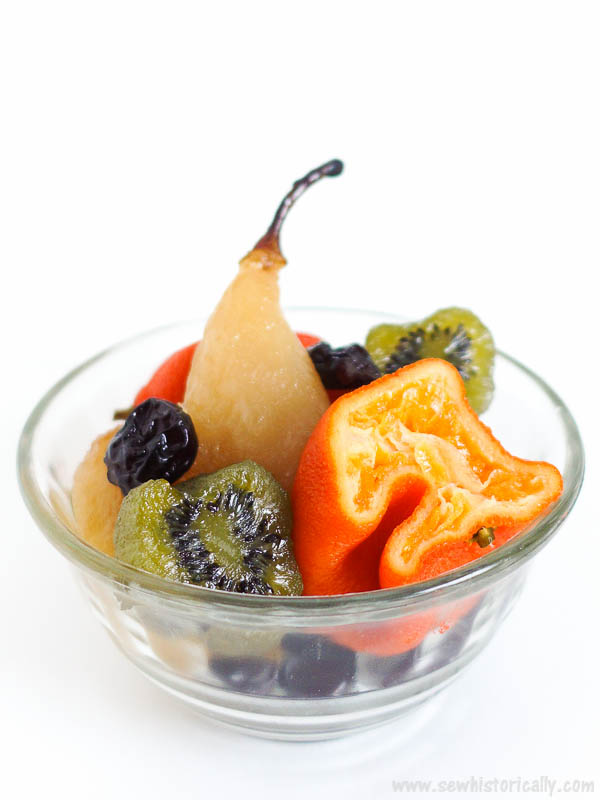
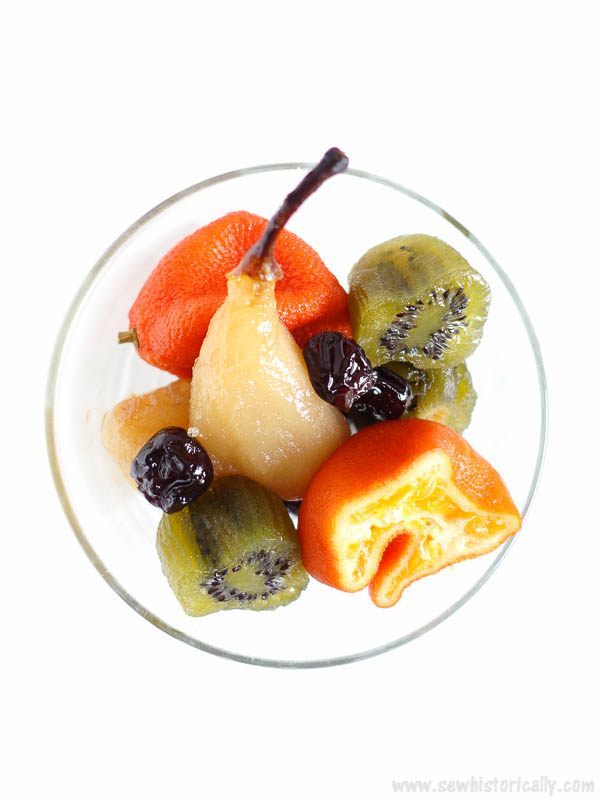
Great recipes. Every other xmas I’m too late buying glace apricot and pineapple for my xmas cake (health shop only stocks limited quantity for few weeks) and have to make my own. I also did rind in great big sections from fruit off my Seville orange tree (much nicer than bought) but I’ve never done whole fruit. I am saving your recipes to try.
Thanks, Karey! 😀 I’m glad you like it!
I love your blog. Subscribed!
Thank you so much, Kristie! 😀
I have never tried this. But it sounds easy enough. Thanks so much!!
XOXO
Jodie
Thanks for stopping by, Jodie!
wow that is quit a process for candied fruit. Interesting how recipes and tastes have changed over the years and here were are exploring what our ancestors loved. Thanks for linking up at #OMHGWW and hope to see you next week!
Thanks, Alice!
I’ve always wondered how this was done. Thank you for showing how its done.
Thanks so much, Lee! 🙂
What a lovely recipe! I might try with whole limes; in Mexico, they stuff whole crystallized limes with coconut shavings.
That’s interesting! Let me know how they turn out!
Very useful recipe, I have always been using candyed fruits never thought of making them myself. Thanks for joining Bloggers Pit Stop – Pit Stop Crew
Thanks for stopping by, Menaka!
this is a new recipe to me sounds super interesting and bet the taste is amazing
Thanks, Angie!
Very interesting recipes. I found some of my Great Grandmother’s recipes that are super old. Some of them have very little info about oven temps or cooking times since she did not have an electric range. Happy Weekend, Kippi
Thank you, Kippi!
I’m going to try whole candid fruits have been looking for a recipe from Italian mustard fruit this one is the best so far. Thank you ?
Thank you so much! I’m glad you like it! 😀
Fantastic info! I’ve always made my own candied rinds of citrus and slices of oranges fir my cakes but I’ve been searching for a recipe for whole fruits and this is wonderful! Thank you so much . I’m going to try small quantities for a special Christmas gift for someone who is hard to buy for but who loves the finer things in life!
Happy Christmas 2021 to everyone when it comes after this awful year ??❤️❤️
Hi can i do this recipe with mini pineapples
Yes, you can use all kinds of fruits. Pineapples were often used to make candied fruits in the Victorian era. 🙂